As a gardener, I find that daffodils are among the first bursts of color to announce the arrival of spring, but their early blooms and subsequent dormant period can leave gardens looking bare. To maintain visual interest throughout the growing season, it’s essential to plant companions that can take over the show once the daffodils have faded. By doing so, you not only get to enjoy a garden full of flowers for a more extended period, but you also can cover the daffodils’ dying foliage, which can be unsightly if left exposed.

Choosing the right companions involves considering bloom time, foliage texture, and height, along with the daffodils’ natural growing conditions. Ideally, these plants should thrive in similar soil and light environments as daffodils, ensuring a harmonious garden bed where both the daffodils and their companions can flourish. The chosen companions can range from other bulbs to annuals or perennials, creating layered and long-lasting displays of blooms in the garden. Through careful selection, daffodils’ bright yellows and whites are naturally highlighted by companions with contrasting or complementary shades.
JUMP TO TOPIC
Cultivating a Vibrant Garden with Daffodils
In crafting a garden that remains lively throughout the year, I’ve found that daffodils serve as an exceptional foundation, due not only to their bright yellow blooms but also to their harmonious relationship with various perennials. The key lies in selecting the right types, proper planting, and caring across seasons.
Choosing the Right Daffodil Varieties
When I select daffodil varieties, I prioritize diversity to extend bloom times and complement other plants. Single early, double early, and naturalizing daffodils each bring unique characteristics to the garden. Naturalizing daffodils are perennials that return year after year, while early varieties offer early blooms to awaken the garden from winter.
Essentials of Planting Daffodil Bulbs
💥 Planting Depth and Soil Preparation
I ensure that the soil is fertile and well-drained, slightly acidic with pH between 6.0 to 7.0. I dig the soil at least 12 inches deep and mix in plenty of organic matter, such as compost, for improved structure and drainage. Daffodil bulbs should be planted at a depth at least twice the bulb’s height, with a minimum of 2 inches.
Caring for Daffodils Through the Seasons
Spring Care:
Once the daffodils bloom, I keep them well-watered without over-saturating the soil. After the blooms fade, I allow the foliage to remain and photosynthesize, which nourishes the bulbs for the next season.
Fall Preparation:
In autumn, I apply a layer of mulch to protect the bulbs from freezing temperatures and to retain soil moisture. Fertilizer isn’t typically necessary if the soil is rich in nutrients, but I sometimes add bone meal to support next year’s growth.
Enhancing Your Garden’s Aesthetic with Companion Plants
Selecting the right companion plants for daffodils is pivotal in creating an eye-catching garden that flourishes throughout the growing season. These companions should ideally complement the bloom time and color palette of your daffodils while also helping to cover up the foliage as it dies back.
The Best Companion Plants for Daffodils
I find that the most striking companion plants for daffodils are those that offer contrasting colors and staggered bloom times. For instance, the rich blues and purples of Muscari (grape hyacinth) or Hyacinths can contrast beautifully against the bright yellows and whites of daffodils. Daylilies and hostas offer lush foliage that emerges as daffodil leaves begin to fade, maintaining the garden’s visual appeal.
Some ideal companions include:
- Muscari: Provides a sea of blue beneath the daffodils.
- Hyacinths: Adds a pop of aromatic purple or blue.
- Daylilies: Emerges later to disguise the daffodil dieback.
- Hostas: Unfurls broad leaves that cover fading daffodil foliage.
Designing Your Garden Layout
When I design my garden, I think carefully about the plant sizes and flowering times. Bordering daffodils with smaller, low-growing plants like Muscari creates a graduated effect. Placing taller plants such as daylilies or peonies behind the daffodils ensures that as the daffodils’ foliage recedes, the emerging plants can provide coverage and sustained color.
Here’s an example layout:
- Front border: Muscari for early spring blue.
- Middle: Daffodils as the main spring highlight.
- Back: Daylilies or peonies for late spring to early summer bloom.
This tiered approach ensures a dynamic and cohesive garden where each plant supports the others, both aesthetically and horticulturally. Remember, the timing and placement of companion planting can make a significant difference in garden aesthetics and overall health.
Managing Pests and Diseases in Daffodil Cultivation
In my experience, maintaining healthy daffodils requires proactive measures against pests and diseases. Here’s a focused approach on prevention and treatment.
Preventing and Treating Common Daffodil Pests
Daffodil pests can be diverse; however, my main focus is usually on common offenders such as bulb flies and aphids. I take preventive steps, such as regularly inspecting for bulb damage and ensuring proper drainage to discourage unwanted guests.
To prevent issues with pests, I follow these strategies:
Clean Cultivation: Removing plant debris to minimize the habitat for pests.
Water Management: Avoiding waterlogging that attracts bulb flies.
If pests are detected, I address them promptly with targeted treatments, such as insecticidal soap for aphids or recommended nematodes for bulb fly larvae. I avoid broad-spectrum insecticides, as they may harm beneficial insects that naturally control pest populations.
Addressing Diseases in Daffodil Plants
Diseases can hinder daffodil growth, with common ones being bulb rot and fungal leaf scorch. My approach is usually twofold: prevention and early treatment.
Disease Identification: Recognizing early signs like yellowing leaves or stunted growth is key to management.
Fungicides: Applying these at the first sign of disease can be crucial.
I’ve learned that fostering strong, resilient bulbs begins with good cultural practices. This means planting in well-drained soil, and at the correct depth, to promote healthy growth less prone to diseases. It’s also important to purchase bulbs from reputable sources to avoid introducing diseases into the garden.












